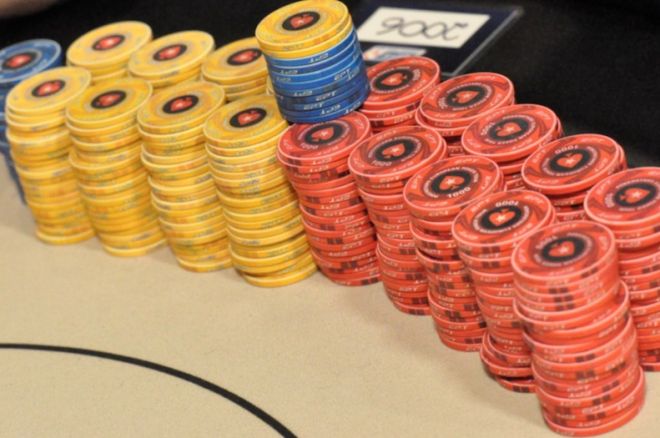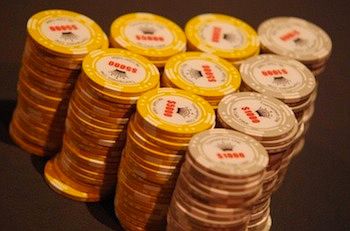Chip Stacking Tips for the New Player

As a tournament reporter for many years, I��ve spent a lot of time eyeing players�� chip stacks, enough to develop all sorts of ideas and opinions about the significance (or lack thereof) of how a player chooses to stack his or her chips.
There are varying degrees of tidiness displayed in chip stacking. Some players are very meticulous about lining up their stacks in perfectly constructed, uniform towers. Meanwhile others tend always to have a few strays laying around, or even have ��dirty stacks�� with chips of different denominations mixed together in a single column.
It��s tempting to perform a kind of ��profiling�� simply from the way a player stacks his or her chips, which like other assumptions based on, say, clothing, appearance, or the player��s sex or age might indicate something meaningful about a person��s playing style. Or not.
We might be tempted to place the guy who lines up the markings on the edges of the chips so all are perfectly aligned in a category of ��tight�� players who never make any moves without having calculated risk-reward ratios to the nth degree. And the guy with messy chips in differently-sized stacks that always appear on the verge of toppling over might be thought of as more ��loose�� with his calls and raises.
New players may find themselves distracted by such speculations. But more often than not when it comes to stacking and handling chips, they��re going to be more focused on what they are doing with their own chips than with worrying about how others are stacking theirs.
Stacking Standards
The symbolism of stacks may be debatable. That said, how players stack their chips is not without meaning. And for new players, it is probably worth knowing some of the standards for stacking.
There��s a whole generation of players now who got their first experience playing poker online which means when they do finally try playing in a live poker room the whole idea of having to deal with chips might well be altogether new. They might know all about starting hand selection, the importance of position, and the odds of drawing to a flush or straight, but stacking chips isn��t necessarily something they��ve faced before.
It might seem like a trivial thing to learn, and in truth it doesn��t take long to become familiar with how to stack chips. But for new players there are a few factors to keep in mind going in.
The great majority of players stack their chips in a similar way, with stacks of 20 being the standard most often employed. Some prefer building 30- or 40- chip high stacks (or more), while others like to stack them in 10s or even in lots of short stacks of five. But 20 is a convenient stack size �� not too high or low, and easy for counting, too.
What Are the Rules?
Most cash games and tournaments have a rule in place acknowledging the necessity of allowing opponents to be able to see your stack clearly enough to have an idea what you have in front of you, although the rule generally still allows players certain freedoms with their chip caretaking.
For instance, in the Poker Tournament Directors Association��s most recent set of TDA Rules currently used in many tournament series, there��s a rule noting that ��Players are entitled to a reasonable estimation of an opponent��s chip count; thus chips should be kept in countable stacks.�� The rule goes on to say ��The TDA recommends clean stacks in multiples of 20 as a standard�� and that ��Players must keep higher denomination chips visible and identifiable at all times.��
These are guidelines often followed by many in tourneys. They are followed in cash games, too, and thus for new players are worth knowing.
- Chip stacks don��t have to be 20 chips tall, but keeping stacks of 20 (or multiples thereof) is what the TDA ��recommends�� (as do others).
- However tall your stacks are, they should be uniform and easy enough for opponents to count simply by looking at them.
- Higher denomination chips always should be visible, too, and not hidden behind lower ones or in other ways �� that also is part of making it possible for opponents to make that ��reasonable estimation�� of what you have when a hand begins or at any point during the play of a hand.

As a tourney reporter, it��s always handy for me when players follow these guidelines as it makes the job of counting their chips and reporting those counts much easier. Take a look at the picture to the right. The yellow chips are worth 5,000 each and the grays are 1,000. How many chips does that player have? How long did it take you to count them? (See below for the answer.)
Some of my colleagues occasionally complain about players not stacking chips neatly or in amounts other than 20. Of course, the players�� obligation to each other and the fairness of the game is certainly greater than their obligation to reporters. It��s essential that everyone be able to play hands knowing how the stacks compare because such knowledge directly affects the strategy employed when deciding whether or not to fold, call, raise, or shove all in.
Conclusion
A lot of times new players don��t want to give away the fact that they aren��t experienced when they sit down in a live game for the first time. It is easier said than done, but inexperienced players shouldn��t worry too much about being pegged as a newbie. Everyone was new to the game once, and if you can try to focus on playing hands as well as you can and not fretting too much over making ��rookie mistakes,�� you��ll enjoy yourself a lot more while gathering experience to help you going forward.
Know, though, that if you stack your chips in 20, keep your stacks relatively orderly, and be sure to keep the big chips up front and visible, you won��t be drawing attention to yourself as someone unfamiliar with how to stack chips.
Now your hand might shake a little the first time you grab some of those chips to raise with your pocket aces and a couple might spill off the top, but you��ll learn to deal with that in time. And as you gather more experience, you��ll gather more chips, too, and thus more chances to stack them.
(With those neat stacks of 20, it is easy to see at a glance in the photo that the player has 680,000 chips. Bonus question: How many chips are in the photo at the top? Yellow = 1,000, red = 5,000; blue = 10,000)
Want to stay atop all the latest in the poker world? If so, make sure to get PokerNews updates on your social media outlets. Follow us on Twitter and find us on both Facebook and Google+!








